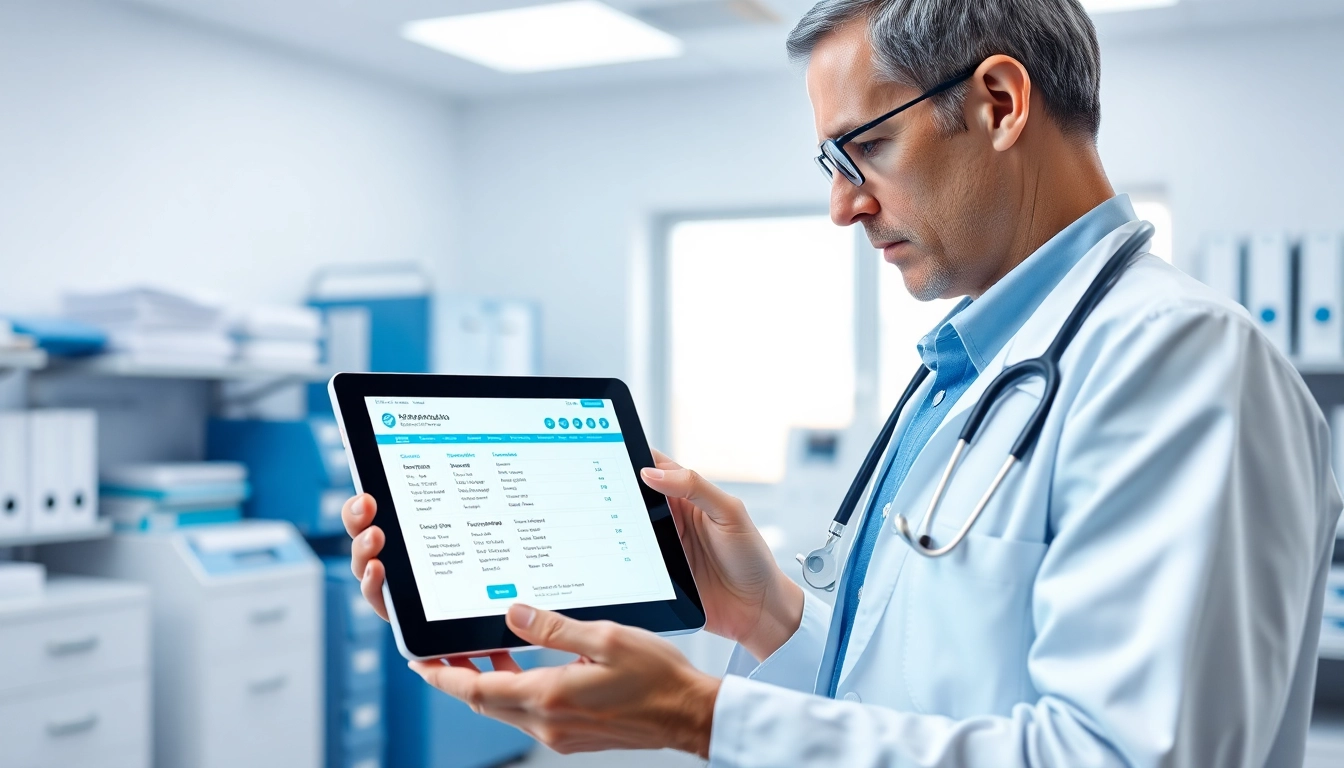Understanding E-Prescription Apps for Android
The healthcare landscape is undergoing a significant transformation, driven largely by technological advancements and the integration of digital solutions into everyday practice. One of the most impactful innovations in this realm is the emergence of eprescription apps for android. These applications provide healthcare providers with the tools needed to streamline the prescription process, enhancing both efficiency and patient care. This comprehensive guide explores what e-prescription apps are, their benefits for healthcare providers, key features to consider, and how they progressively reshape patient care and practice management.
What are E-Prescription Apps?
E-prescription apps facilitate the digital creation, management, and transmission of prescriptions from healthcare providers to pharmacies. Unlike traditional methods that involve paper prescriptions—which can be prone to errors, misinterpretation, or even fraud—e-prescribing enables a secure and efficient workflow, ensuring that medication orders are accurate and easily accessible. These applications are designed with user-friendly interfaces and robust security measures to protect patient information while simplifying the prescribing process.
Benefits of Using E-Prescription Apps for Healthcare Providers
The adoption of e-prescription apps offers numerous benefits, equipping healthcare providers with capabilities that were previously challenging to manage. These apps significantly contribute to practice efficiency, higher accuracy in prescriptions, and improved patient outcomes. Key benefits include:
- Enhanced Efficiency: E-prescription apps minimize the time spent on writing and managing prescriptions, allowing healthcare providers to redirect that time toward patient care.
- Fewer Errors: The risk of misinterpretation is significantly reduced as prescriptions are transmitted electronically, supporting clearer communication between providers and pharmacists.
- Improved Patient Safety: E-prescribing includes features such as drug interaction checks, allergy alerts, and dosage recommendations, enhancing patient safety during medication administration.
- Compliance and Documentation: Digital prescriptions provide an audit trail that assists in meeting regulatory requirements and ensuring accuracy in patient documentation.
Key Features to Look for in E-Prescription Apps
When evaluating e-prescription apps for implementation in healthcare practices, it is crucial to consider specific features that align with the needs of both healthcare providers and patients. Essential features may include:
- User-Friendly Interface: An intuitive design helps healthcare providers quickly adapt and minimizes training time.
- Mobile Compatibility: Apps that work across various mobile and desktop platforms facilitate access and utilization in diverse practice settings.
- Security Measures: Look for applications that comply with HIPAA regulations, offering secure data transmission and storage.
- Integration Capabilities: The ability to integrate seamlessly with electronic health records (EHRs) and pharmacy management systems enhances overall functionality.
- Real-Time Notifications: Features that update healthcare providers on prescription status or refill requests help maintain streamlined communication with both patients and pharmacies.
How E-Prescription Apps Enhance Patient Care
Utilizing e-prescription applications not only streamlines healthcare provider workflows but directly improves the quality of patient care. Here are several ways e-prescription apps influence patient engagement and safety positively.
Improving Medication Adherence Through E-Prescription
Medication adherence remains a significant challenge in healthcare, with many patients failing to take medications as prescribed. E-prescription apps contribute to enhancing adherence by:
- Ease of Access: Patients can receive medications promptly and conveniently through automatic refills and notifications, reducing barriers to medication access.’
- Education: E-prescription apps can include educational materials about the prescribed medication—dosage, potential side effects, and lifestyle considerations—promoting awareness and understanding.
Reducing Prescription Errors with Digital Solutions
Prescription errors can have grave consequences for patient safety and healthcare costs. E-prescription apps mitigate this risk by utilizing technology to:
- Validate Prescriptions: Applications often include built-in checks for drug interactions, dosage discrepancies, and patient histories, all of which alert healthcare providers to potential errors before prescriptions are finalized.
- Confirm Identity: Secure patient verification processes help ensure that the right patients receive the right medications, enhancing overall safety.
Facilitating Communication Between Doctors and Patients
A seamless communication flow between healthcare providers and patients is vital for effective care delivery. E-prescription apps facilitate this communication by:
- Providing Updates: Notifications can be sent directly to patients regarding prescription statuses, refills, and adherence reminders, reinforcing proactive engagement in their care.
- Feedback Opportunities: The apps may include features for patients to ask questions or provide feedback about their medications, fostering a collaborative healthcare environment.
Comparison of Popular E-Prescription Apps for Android
With a wide array of options available on the market, healthcare providers must choose the right e-prescription app that aligns with their practice goals and patient needs. Below, we explore several popular e-prescription apps for Android, highlighting their core functionalities and differences.
Overview of Top E-Prescription Apps
Several prominent e-prescription applications have gained traction among healthcare providers due to their robust features and usability. Commonly recognized apps include:
- iPrescribe: Known for its user-friendly interface, this app allows providers to prescribe medications quickly via mobile devices, with features aimed at improving patient adherence and communication.
- MDToolbox-Rx: This solution offers an extensive array of e-prescribing functionalities, including secure messaging and integration with EHR system.
- ScriptSure: Focused on providing a comprehensive electronic prescribing service, ScriptSure enhances medication management and patient education through insightful alerts.
Feature Comparison and User Feedback
When evaluating the effectiveness and user satisfaction of the leading e-prescription apps, it’s essential to consider key distinguishing attributes such as usability, customer support, and overall practitioner ratings. Feedback from providers indicates a general appreciation for:
- Integration Capability: Users prize apps that seamlessly connect with existing EHR systems to minimize workflow disruption.
- Customer Support: Responsive technical support teams are often highlighted in reviews, significantly influencing user satisfaction.
Pricing and Subscription Models
The financial implications of adopting an e-prescription app can influence decision-making for many healthcare providers. Various pricing models exist, including:
- Subscription-Based: Many apps charge a monthly or annual fee, which may include additional costs for premium features or multiple user licenses.
- Pay-Per-Use: Some applications offer a pay-per-prescription model, which can be more cost-effective for smaller practices with less frequent prescriptions.
Implementing E-Prescription Apps in Your Practice
Successfully integrating e-prescription apps into healthcare practices requires strategic planning and comprehensive staff training. Below are the steps to ensure smooth implementation.
Steps to Effectively Integrate E-Prescribing into Workflow
The effective implementation of e-prescription apps necessitates a systematic approach:
- Needs Assessment: Evaluate your practice’s needs and determine how an e-prescription app can enhance efficiency and patient care.
- Selection of Application: Research and select an application that best aligns with your practice, considering patient demographics and medication management challenges.
- Trial and Feedback: Conduct a trial period with a smaller group of users to gather feedback and make adjustments before full-scale implementation.
- Full Implementation: Once adjustments are made, roll out the application to all providers within the practice, ensuring everyone is properly trained.
Training Staff on E-Prescription Technologies
Proper training is essential for optimizing the benefits of e-prescription applications. Effective strategies include:
- Hands-On Workshops: Organize workshops to familiarize staff with the app’s features and functionalities in a hands-on setting.
- Comprehensive User Guides: Provide detailed instructional materials that emphasize best practices and troubleshooting to empower staff to operate the technology efficiently.
- Ongoing Support: Offer continued access to support resources and periodic refresher courses to ensure all staff remain confident and updated in using the app.
Monitoring and Evaluating Performance Metrics
Once the e-prescription app is implemented, practices must monitor its effectiveness and efficiency by tracking several performance metrics:
- Prescription Accuracy Rates: Monitor the accuracy of prescriptions transmitted to pharmacies to identify areas for improvement.
- Provider Adoption Rates: Analyze the usage rates among healthcare providers to gauge the app’s acceptance within the practice.
- Patient Adherence Rates: Track patient feedback and adherence metrics to assess the overall impact on patient care and outcomes.
The Future of E-Prescription Apps in Healthcare
The evolving landscape of healthcare technology will lead to ongoing advancements in e-prescription applications, pushing toward increased patient-centric approaches and improved outcomes.
Emerging Trends in E-Prescription Technology
As e-prescription technology continues to evolve, several emerging trends are shaping the future:
- Artificial Intelligence (AI): AI-powered tools that can understand patient history and predict medication needs are becoming increasingly popular for refining prescription processes.
- Telehealth Integration: The growing prevalence of telehealth will likely lead to more robust integration between telehealth platforms and e-prescribing apps, creating cohesive patient management solutions.
Impact of Regulations on E-Prescription Solutions
Regulatory frameworks will continue to influence the development of e-prescription applications. Compliance with evolving laws and guidelines, including data privacy regulations, will shape how these applications function and are adopted by healthcare providers.
Predicting Future Developments in E-Prescription Apps for Android
The ongoing advancements in technology suggest that e-prescription apps will become even more advanced with features that further enhance provider and patient experiences. Potential innovations could include:
- Enhanced Interoperability: Apps designed to work smoothly across various healthcare systems, allowing comprehensive health data exchange.
- Wearable Device Integration: Future apps may incorporate data from wearable devices, offering real-time insights that inform prescribing and dosing decisions.
In conclusion, as e-prescription apps for Android become an essential element of healthcare practices, understanding their functionalities and advantages is crucial for healthcare providers aiming to improve patient care and operational efficiency. The shift toward digital solutions promises not only convenience but also enhanced outcomes for patients, making them increasingly vital in modern healthcare.



